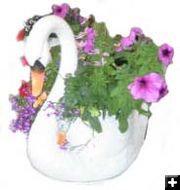
NEXT MEETING:
Tues, March 17, 5:30PM
In the Cooperative Extension Service Office at 621 S Pine, Pinedale. Come at 5PM for social time.
|
|
Dig It! - Intensive Gardening
For More Produce in Less Space, Part 1
by Sage and Snow Garden Club
February 26, 2009
Over the next few months, we will have articles on intensive vegetable gardening that include such techniques as interplanting, vertical gardening, succession planting, and relay planting. An intensive garden minimizes wasted space. The practice of intensive gardening is not just for those with limited space, but also concentrates your work to create an ideal plant environment. The ideal is to have something growing in every part of the garden at all times during the growing season, which is especially important with our short growing season. Facets of intensive gardening can also be applied to flower and herb gardening.
Intensive gardening requires early, thorough planning to make the best use of your time and space. Before planting, consider the interrelationships of plants, including nutrient needs, shade tolerance, above- and below-ground growth patterns, and preferred growing seasons.
When the cold days of winter seem never-ending, pull out last year’s garden records and dig into your new seed catalogs. As with any garden, you must decide which crops you want to grow based on your own likes and dislikes, as well as how much of each you will need. Take soil samples as early as possible to avoid waiting for results during the busy spring soil sampling time. Go back to your journal and see which varieties were most successful or tasted best. Consult companion-planting guides and your own experience to determine which crops are likely combinations. Good gardening practices (watering, fertilizing, crop rotation, composting, and sanitation) are especially important in an intensive garden.
Soil preparation is key to successful intensive gardening. Plants compete for water and nutrients, so these are especially important for more closely spaced plantings. Do a soil test so you know if and how much organic matter, phosphorus (P), potassium (K), calcium (Ca), magnesium (Mg), and micronutrients (iron, manganese, zinc, copper) your soil needs. Nitrogen (N) fertilizer additions will be crop specific.
The raised bed or growing bed is the basic unit of an intensive garden. A system of beds allows you to concentrate soil preparation in small areas, resulting in the efficient use of soil amendments and an ideal environment for plant growth. Beds are generally 3 to 4 feet wide and as long as you desire. You work from either side of the bed, reducing compaction caused by walking on the soil. Raised beds are a form of wide-bed gardening, a technique by which seeds and transplants are planted in wide bands of several rows or broadcast in a wide strip. The goal is to space plants at equal distances from each other on all sides, such that leaves will touch at maturity. This saves space and the close plantings reduce moisture loss from surrounding soil.
The next Sage and Snow Garden Club meeting will be March 17, 5:30 pm, in the Cooperative Extension Service Office at 621 South Pine, Pinedale. Come at 5 pm for social time. Contact us at Box 2280, Pinedale, WY, 82941, by email at sageandsnow@yahoo.com or call 307-859-8606.
|
